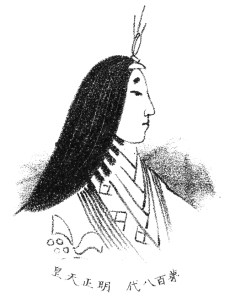
By Gabby Storey
Meishō was born 9 January c.1624/26 to Emperor Go-Mizunoo and Tokugawa Masako, who was the daughter of the second Tokugawa shōgun, Tokugawa Hidetada, whose father was the first Tokugawa shōgun.
Meishō became empress regnant aged 5 on 22 December 1629 following the abdication of her father. Go-Mizunoo abdicated following his bestowal of honorific purple garments to ten priests, which was banned at the time.
Meishō reigned for fifteen years until she abdicated in favour of her half-brother Go-Kōmyō. During her reign she faced religious rebellion and revolts which were forcefully dealt with, though the extent of her involvement in this quelling is unclear.
Meishō does not appear to have married, and produced no children, therefore being succeeded by her half-brother Go-Kōmyō. She was the seventh empress regnant in Japanese history. She died on 4 December 1696 and was buried at the imperial mausoleum, Tsuki no wa no misasagi, Kyoto.
Meishō’s reign, like that of the other empresses regnant, is interesting because of their accession and succession – with the exception of one, all empresses regnant chose a male successor as their heir.
Recommended Reading
Atsuko Hirai, Government by Mourning: Death and Political Integration in Japan, 1603-1912 (Cambridge: Harvard University Asia Center, 2014)
Marius B. Jansen, The Making of Modern Japan (Cambridge, MA: Harvard University Press, 2000)
Richard Ponsonby-Fane, The Imperial House of Japan (Kyoto: Posonby Memorial Society, 1959)
